Fundamentals of project management office
Question:
Evaluating the the implementation and benefits of a Project Management Office?
This paper is written with an aim to understand the benefits as well as implementation PMO so that these can be evaluated and lessons can be learnt on best practices. The results of this research would primarily help an organization planning to adopt or implement PMO in the organization as it would cover the basic building blocks of the practice as well as discusses some cases to illustrate the process of implementation, its effects on the organization and on the realization of benefits against projects which is the main goal of any Project management Office.
To fulfil these aims, the paper has discussed the fundamentals of project management office, explored its dimensions including focus, operational modes and maturity that are important to understand as it would establish a basis for selection of project management office structure.
Further, the paper discusses the implementation process of PMO and illustrates the same with a case study of an organization in which PMO has been implemented successfully. The cases are used for evaluating the process of implementation of PMO as well as the benefits obtained from the same after implementation. The insights obtained from the case are discussed for bringing for the lessons as well as recommendations is made for using best practices for implementation of the project management office.
Project is a temporary endeavour, which has definite start, definite end, and specific goals or benefits to be achieved or realized on completion. Project Management involves planning, organizing, resource management and managing security of projects.
Project Management Office is a department within an organization that manages and controls project based activities of the organization. PMOs standardize project management methods based on Project Management principles in order to achieve benefits for the organization. PMO guides the organization through management of various projects, and provides required documents as well as performance metrics.
During recession, companies have faced many challenges that made achieving benefits from projects very important. History has shown several failed projects that have lead to huge losses. Thus, there is an increase urgency to use project management methods for making projects successful, as failing projects are no more accepted. The failed projects are also required to be studied to learn lessons. Project Management Office makes all this possible in an organized and standardized way which makes it uncomplicated to adopt project management practices to achieve benefits from projects.
In 2000, there were only 47% of US organizations that had Project Management Office for managing projects but this figure has increased significantly to 84% by 2010 which showing the increasing importance and adoption of PMO across organizations.
To realize the key aim that is to get significant benefits out of projects, the PMO must be implemented as well as worked out properly. Thus, this dissertation focuses on benefits of the PMO and how they can be realized in practice as well as on the implementation process of PMO. For new companies adopting PMO, this paper can serve as a guide to using best practices for implementation of PMO so that the results could be appreciable when the PMO starts to act on projects in the organization.
Types of PMOs and their dimensions
The increasing importance of PMO is recent years has lead to development of different types of PMOs that are established by organizations. These include departmental PMOs, special purpose PMO, supplier PMO, external PMO, and Enterprise PMOs.
Internal and external PMOs manage specific parts of organizational commitments such as service and support are managed by external PMO that directly deals with customers while internal PMOs manage self-improvements within the organization. Most organizations use departmental PMOs that have internally focused and which consist of small group of manager working on specific types of projects. However, such type of PMO has its limitations especially when resources have to be accessed from outside the department.
Thus, an Enterprise PMO may used for overcoming these drawbacks. An enterprise PMO would have both internal and external PMO responsibilities and work across organization for managing resources and project deliveries.
The focus of PMOs that can be internal or external makes only one dimension of PMO, others include operational modes that can be supportive, controlling, directive or blended with all three models combined, and maturity of PMO which can be ad hoc, defined, controlled, measured or optimized. All these dimensions are important to understand as they can be taken into consideration while establishing a PMO in an organization (Taylor, 2011).
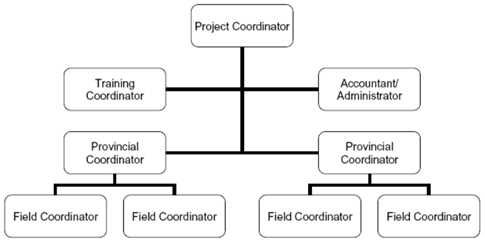
Figure 1: Project Organization Chart
A project organization includes creation of project structure, implementation of that structure and application of it. Project organization structure includes project managers connected with formal relationships, project beneficiaries and stakeholders. The structure must be simplified and allow effective interactions. It should not be very loose or even very tight and must provide a formal environment that influences project team to perform their duties in best way with collaboration assisting them. This collaboration should be made cost effective such that there is no or least duplication any work or task.
While designing a project management office structure, specializations and coordination needs have to be considered. A project may require a specific specialization or a mix of capabilities from different specializations. Thus, on every project, the goals can vary and thus, a different structure may be required for managing a project, which presents a challenge while establishing a PMO structure.
Further, the goals of a project are divided into tasks for specific components of the project and these tasks are listed in a Work Break Down Structure. A project manage has to ensure that these project components are integrated the right way to achieve goals of a project. Thus, based on the project goals, components may vary and thus, the organization structure requirement would also vary.
Thus, in order to establish an effective PMO structure, it has to be made flexible enough to be modified for different projects based on project goals, components and tasks.
Various types of PMO structures can be programme based, matrix based or project based.
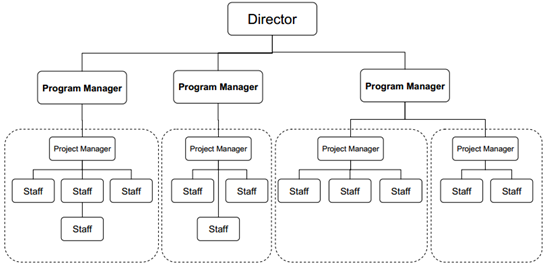
In program based PMO's, project teams are created by including employees from same area. This structure has clear line of authority and in case of big projects a team does not need to use resources from other departments or project team. However, all team members included may not have all required expertise for specific projects if they require speciality resources. Moreover, several members of the team may not be working on some projects for full time, as they would be involved with other projects as well. This can affect their capabilities to complete work on time.
PMO implementation process and case study
Matrix based organizations have staff with specific technical competencies and the can be sourced on the basis of specific project requirements. In such an organization, people could be working on multiple projects and reporting to multiple project managers for each of those projects. This structure provides efficient resource utilization including specialist skills that cannot be used full time on projects. It is very flexible to changing needs of projects. For instance, one unit manager can source a staff member from another unit manager without the need of making a permanent change in the organization structure. Moreover, team members can easily share information across organization as well as can learn specific skills related to different specialization allowing them to grow in the company.
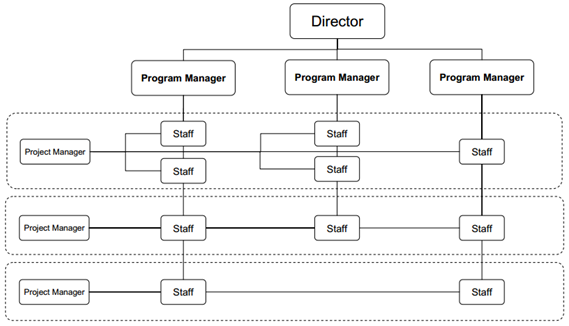
However, this structure is very complex when concerning reporting. Team members are required to have very strong time management skills to be able to handle multiple projects and report to multiple managers. A very strong coordination is required between all programmatic unit managers as well as project managers. While managing projects in such organization, it becomes very difficult for project managers to complete projects, as they have to satisfy more than one programmatic managers who may be having different objectives and priorities.
These types of organizations are usually practiced in large projects that can afford an organization structure with duplication of tasks. However, in such a organization, resources are not utilized cost efficiently as they would be working dedicatedly working on projects full time even when they are not required full time. As project team members would be absorbed on specific projects even after they are not required, they cannot be taken on other projects which limits their learning and professional development. Another concern is that there is duplication of resources and after every project completion, resources have to be reallocated.
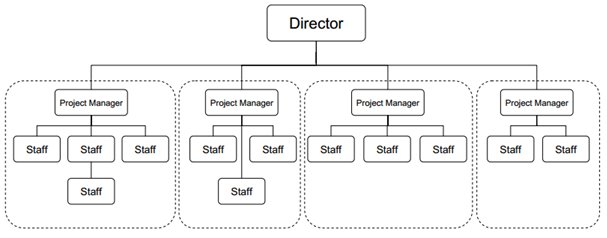
Mixed structure is formed out of the three different structures such that different requirements of different projects can be easily accommodated and benefits of all the three structures including program, matrix and project can be realized. For instance, a small project requiring limited resources can take people for part-time from other units while a large project can source members for full time from the project based structure (Diaz, 2007).
Key responsibilities of PMO include use of project management practice, development of project management methodology, training and certifications management, resource management, project reporting, coaching, mentoring, supporting, quality control, financial monitoring and support, project selection and decision making.
Stakeholders are people, groups or entities that are affected by the success and failure of an action or those who affect the performance of an action which in the case of project management office is leadership of the PMO. Thus, stakeholder management is an important task for any project driven organization.
Various stakeholders of PMO include board members, executive team of project organization, business leaders, operation managers, project sponsors, partners, customers and the leader of PMO. To manage stakeholders, PMOs can use the basic process of stakeholder management, which involves stakeholder identification, analysis, creation of influence maps or stakeholder matrix, stakeholder engagement and maintaining of communication flow with stakeholders.
Benefits of implementing PMO
The different types of PMO structure provide a platform and a platform to decide which PMO structure in which scenario i.e. for specific project matrix based PMO is a good option whereas project based PMO is a better option for large projects.
Any new implementation in an organization is always aimed at improving something's or addressing a pain or a gap, it applies to the implementation of PMO. Thus, the initial step of planning a PMO would include identification of issues that are to be resolved or the benefits that are sought. For instance, a PMOs may be set up for addressing issues like low quality of deliverables, budget overruns, and so on or for gaining a benefit of avoiding lost opportunities.
These issues or benefits have be assessed by recording them and analysing the experiences of the organization against them. In this stage, it is also important to talk to stakeholders, and take their inputs to finalize the assessment. A proper way of assessing these benefits or issues would be quantification of their impacts.
After assessment is done, next step would be to develop benefits statements for the PMO, which would set a growth plan for the PMO in the organization. This benefit statement can cover different aspects for improvement including people, process, and promotion, performance, and project management information system.
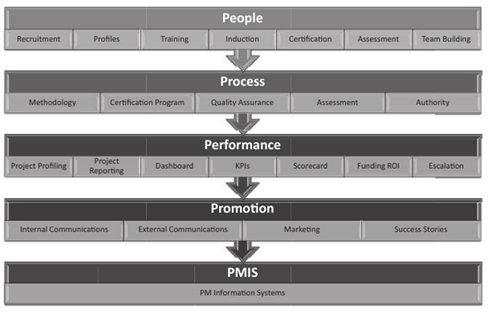
For instance, some benefits that a PMO would bring to these elements of the project organization could be:
- People: Train people on project management, build teams, conduct inductions or assess performances.
- Process: Develop methodology, incorporate certification programs, establish quality assurance process or assess process performance.
- Performance: Project profiling, dashboard creation, KPI development, business scorecard creation or managing funds for ROI.
- Based on the benefits sought, a benefit statement could include "Bettering performance by making timely deliveries" if project aspect is considered or "Improve efficiency of projects by standardizing methods and operations used" if business aspect is considered. Other examples of benefit statements include higher resource utilization by improving allocation of resources and capacity planning, improving prioritization of works by setting realistic insights, improving project status reporting by making it fast and accurate, improving customer satisfaction by ensuring that project deliverables meet customer expectations, etc.
Before finalizing the benefits statement, project leaders must also seek views of stakeholders and only after their approval should the statement be sealed. After the benefits statement is known, the next step is to decide on the type and model of the PMO for which the three key dimensions of PMO including focus, operational modes and maturity have to be explored.
Once the basic structure to be used for PMO is decided, an evolution plan has to be created for development of PMO. This plan starts at the department level and expands gradually to scale up to the enterprise in future after gaining experience and having a track record of successful project completions.
Arcelik was an R&D Centre that had Research and Development Units in multiple locations for certain products including washing machines, dishwashers, refrigerator, coolants, dryers, compressors, televisions and monitors. The organization had 22,000 employees and production plants in 14 different locations across five countries including China, Turkey, Romania, Russia and South Africa. At global level, their sales and marketing groups were spread across 20 countries for managing 10 brands of the company including Arçelik, Beko, Grundig, Blomberg, ElektraBregenz, Arctic, Leisure, Flavel, Defy and Altus.
The PMO was established in manufacturing locations of the organization in 1997, with aim to monitor multiple projects simultaneously. There was a central R&D PMO that was used as an excellence centre, which shared their knowledge with plant PMOs. The PMO was established in the organization through four key phases.
In the first phase, a project management software was installed at the central R&D PMO, which was established in the head office of the company.
Importance of PMO in organizational commitments
In second phase, an assessment was done on the organizational employees against their awareness about project management. Those who did not have the required knowledge have to be trained on project management practices. In this phase, the project management software was also implemented in number of plant locations. This assessment included study of different dimensions of Project Management including:
- Project Management elements like time, resources, budget, risk, change and knowledge.
- Project Management Maturity aspects such as Project Management Methodology, software usage, coaching, planning, controlling and reporting.
Further, best practices for project management were communicated to different groups. These practices included internalization of project management methodology, project review meetings, organization wide use of standard project templates and stage gate implementation.
The result of the assessment was a discovery of areas for improvement and these were project leader trainings, change management, and performance evaluation.
In the third phase, the process of establishment was coordinated and project management was initiated by all production as well as technical groups. The project management process that was to be followed according to the software installed was assessed and integration was carried out with other existing tools and processes. This involved establishing of a standard for project life cycle for all projects at Arcelik.

In the last phase, all projects were properly defined and project leader as well as project team members were trained on project reporting through the project management software installed.
Justifying case study
The case was chosen as the goal of establishing the PMO was very clear as they wanted to monitor their projects that were carried out at multiple locations, from a central place. Another reason for choosing this case was that the organization was large and was project driven. Thus, the need for establishing project management office was prominent. Moreover, the PMO implementation process was carried out in a very organized manner in the company. Moreover, the researcher could extract clear learning from the case study where project management principles could be applied for understanding the situations.
After the PMO was established and was successfully ran, by 2012, some improvements were observed in the company including improvements in 30% of the projects managed and development of new projects that added 30% to the total count of 900 projects in the year. 20% of project successfully completed were on technology development and 20% were investment related (Crawford, 2001).
The proposed paper will make use of sample which is composed of firms existing within the same corporate. along with this, a cross sectional design will be used. the survey consists of a questionnaire having questions framed out from the identified factors. It is an online based set of questions with 15 close ended questions on every factor. It was developed using IBM SPSS base software. The survey chosen is a self-administered because of low costs and easily maintenance. Articles were not used for examination because of cost involved and contradictory results achieved from them. since firms involved are present at different locations so the online survey will greatly reduce the time, effort and cost involved in getting the response by the researcher. Though it has a plus point of cost-effective but it comes with a weakness which cannot be ignored. It will require internet connectivity which is still an issue in developing countries. Also the resources which are going to take this survey should have computer skills in order to carry out the survey properly.
Project organization chart
Some key learning obtained from the evaluation of the PMO implementation at Arcelik were:
- PMO requires a significant change in the working culture of the organization and thus, it takes a lot of time to carry out these changes.
- Coaching and mentoring were very important in working of PMO. Moreover, regular meetings between team members at each project office were required.
- PMO primarily worked on the people aspect and involved convincing of all stakeholders, failing which PMO would not have flourished in the organization.
- Support from the upper management was crucial and thus, regular meetings were to be held between them and project leaders.
- Initially, a pilot has to be started for project and the projects must be completed in a step-by-step manner, as it would make the process simpler and faster.
- Proper integration with other processes was important and time consuming. As a result, roadmaps and long term plans were required to be made for integration.
One primary task of PMO is to manage complexities of the project such that the project is completed on time and within budget as well as gives all the deliverables promised. Thus, understanding how complexities can be managed on projects is crucial. For this, an understanding of the complexity in terms of project would be required. Complexity is one important dimension in project management, as complex projects need strong management. Complexity can be explained in terms of differentiation that is presence of number of elements such as tasks, components and specialists, and in terms of connectivity that is the degree of relationships between these elements (Austin, Newton, Steele, & Waskett, 2002).
Differentiation can be vertical caused by a large set of hierarchies or horizontal resulting from multiple number of organizational units or task structures. Connections in these elements can be explained by interdependencies between organizational units resulting into high level of complexity.
Complexity is managed by proper integration, which involves creation of coordination and communication between different elements of complexity as well as establishing of control over these interdependent components (Baccarini, 1996).
Human Resource Management is one of the crucial domains of the success of any organization and thus, it becomes important to study the level of importance it carries in the project management which involves management of multiple resources out of which human resource is one. Administrative functions of an organization are important in the success of the project and thus, human resource management on a project must be efficiently carried out by PMOs (Belout & Gauvreau, 2004).
For managing HRM on projects, certain key processes are involved. These include Recruitment and selection, training and development, performance appraisals, and deployment of employee compensation system.
Implementation of PMO can have significant effects on an organization such as:
- The working culture of the organization changes drastically as people have to learn to adopt project management principles and practices
- The levels of monitoring increase as the PMO would be keeping check on the progress of projects. This could appear to be a little binding for project managers but for the organization, it can be considered as an efficient way of working as it could lead to transparency in setting responsibilities.
- As the organized project management practices are deployed in organizations adopting PMOs, the number of projects that complete within allotted time frame and within budget would increase, as these are the focus of PMOs.
- Training would become crucial in the organization, as project management practices require understanding of methodologies, standards as well as related technologies.
- Initial adoption of project management practices could appear complicated as lot of learning would be required but in the long run, processes would be simplified, improved and would become faster.
- As PMOs integrate both older and new processes, the organization would be able to stand as a single uncomplicated entity where everyone and every process would be connected in some way.
- PMOs would practice standardization at the organizational level and thus, everyone in the organization would be able to use standard processes, methodologies and documentations which would improve efficiencies by saving on time that would otherwise be wasted in developing processes, methodologies and documents for individual projects.
- PMOs would not only manage existing projects but would also create a learning repository based on previous projects which would allow project teams to learn from past projects such that mistakes could be avoided in future projects as well as best practices could be used repeatedly for success.
Conclusions
This paper was concentrated on understanding of the process of implementation of a project management office and evaluation of its efficiency in terms of gaining benefits for a project driven organization. It covered fundamental concepts of project management office, it dimensions and implementation process. It also explained different types of project management organization structures including program based PMO, matrix based PMO and project based PMO. It was found that many organizations practiced a structure, which is a mix of these three types of organizations and thus can utilize the benefits of all while avoiding loopholes.
For practical understanding of the implementation of PMO, a case study of a multinational organization was taken which gave some practical learning such as: Training is crucial in a project oriented organization; PMO implementation requires change of the working culture of an organization which cannot be carried out in short time but requires significant time for adoption, etc. Two key functions of PMO including management of complexities and human resource management were also discussed and it was found that integration was the key to managing complexities while HRM on project required certain practices to be followed such as Recruitment and selection, training and development, performance appraisals, and deployment of employee compensation system. Lastly, the implications of deploying a PMO in an organization, which is new to project management practice, were summarized. It required an organization to understand the project management principles, train their employees on the same, create documentations for new processes and integrate new processes with old processes for smooth functioning of the organization managing projects. Team members should also record project progress, issues and learning in central project repository to allow members of future projects to use these learning to enable best practices as well as avoid mistakes in future.
References
Polat, M., & Meydanlı, İ. İ. (2013). Case study: project management office implementation in a multilocation. Picmet.
Austin, S., Newton, A., Steele, J., & Waskett, P. (2002). Modelling and managing project complexity. International Journal of Project Management , 20, 193-198.
Baccarini, D. (1996). The concept of project complexity : A Review. International
Journal of Project Management , 14 (4), 201-204.
Belout, A., & Gauvreau, C. (2004). Factors influencing project success: the impact of human resource management. International Journal of Project Management , 22, 1-11.
Diaz, P. L. (2007). Management for Development. IMPACTO4DEV .
Rathore, A. (2010). The growing importance of EPMO (Enterprise Project Management Office) in today’s organizations. Wipro Technologies.
Lowth, G., Prowle, M., & Zhang, M. (2010). The impact of economic recession on business strategy planning in UK companies. Research executive summary series , 6 (9), 1-9.
Prabhakar, G. P. (2008). Projects and Their Management: A Literature Review . International Journal of Business and Management , 3 (8), 1-9.
Project Management Solutions, Inc. (2014). The State of the Project Management Office (PMO). USA: PM Solutions.
Seymour, J. E. (2010). The Enterprise Mystery Unravelled. Lexington, Kentucky: Seymour Books.
Siles, R. (2004). Project Management Information Systems. CARE.
Nicholas, J. M., & Steyn, H. (2008). Project Management for Business, Engineering, and Technology: Principles and Practice (3rd ed.). Oxford, UK: Elsevier Inc. .
Sprouse, L. (2010). THE INFLUENCE OF THE EFFICACY OF THE PROGRAM MANAGEMENT : OFFICE ON IT PROJECT SUCCESS RATES . UNIVERSITY OF PHOENIX .
GDE. (n.d.). Project Management Methodology Guidelines. Retrieved 2015 ùøû 12-February from https://www.chandleraz.gov/content/pm000pmmethodologygde.pdf
Balestrero, G. (2006). Executive Guide to Project management. PMI.
To export a reference to this article please select a referencing stye below:
My Assignment Help. (2016). Understanding PMO: Implementation Process And Benefits (Essay).. Retrieved from https://myassignmenthelp.com/free-samples/implementation-of-pmo.
"Understanding PMO: Implementation Process And Benefits (Essay).." My Assignment Help, 2016, https://myassignmenthelp.com/free-samples/implementation-of-pmo.
My Assignment Help (2016) Understanding PMO: Implementation Process And Benefits (Essay). [Online]. Available from: https://myassignmenthelp.com/free-samples/implementation-of-pmo
[Accessed 28 April 2025].
My Assignment Help. 'Understanding PMO: Implementation Process And Benefits (Essay).' (My Assignment Help, 2016) <https://myassignmenthelp.com/free-samples/implementation-of-pmo> accessed 28 April 2025.
My Assignment Help. Understanding PMO: Implementation Process And Benefits (Essay). [Internet]. My Assignment Help. 2016 [cited 28 April 2025]. Available from: https://myassignmenthelp.com/free-samples/implementation-of-pmo.
